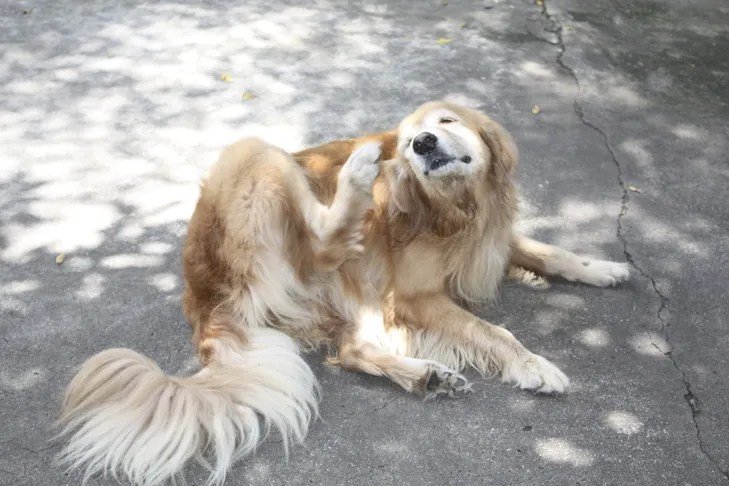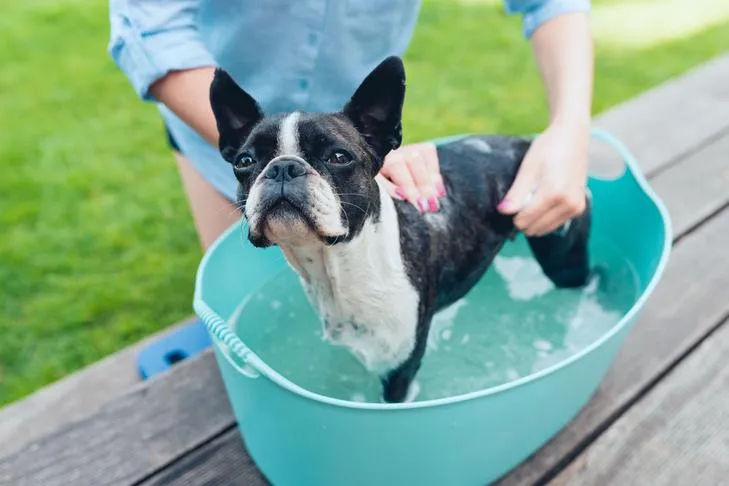A common concern among pet owners is whether parasites can jump from humans to their beloved canine companions, and vice-versa. Specifically, many wonder, “Can A Dog Get Human Head Lice?” The good news is a resounding no: dogs cannot get human head lice, nor can humans contract lice from their dogs. Lice are strictly species-specific, meaning the variety that thrives on human blood will not find a dog’s coat hospitable, and similarly, dog lice are adapted only to their canine hosts.
While the direct transfer of head lice isn’t a concern, dog lice are a genuine parasite problem for canines that can lead to significant discomfort and health issues. Understanding the unique characteristics of dog lice, how to identify them, and effective treatment methods is crucial for any responsible pet parent. This article will clarify the species-specific nature of lice and guide you through managing a dog lice infestation, ensuring your furry friend stays healthy and comfortable. For a deeper dive into whether a dog can contract lice from a human, you can find more information here.
The Species-Specific Nature of Lice
The reason human head lice ( Pediculus humanus capitis ) cannot infest dogs, and dog lice cannot infest humans, lies in their specialized biology and adaptations. Lice have evolved alongside their hosts, developing specific physical characteristics, such as hook-like claws tailored to the precise diameter of their host’s hair shafts or feathers. These specialized claws allow them to cling securely to hair, making it virtually impossible for them to attach effectively to a different species’ hair type.
Beyond physical adaptation, the dietary requirements of lice are also species-specific. Human head lice feed on human blood, while dog lice are adapted to consume canine blood or skin debris and secretions. Their digestive systems and chemical receptors are finely tuned to their particular host, making cross-species feeding unviable. This biological barrier provides a natural defense against transfer, reassuring pet owners that they won’t share their head lice with their dog, and vice versa. It’s also important to understand that can dog lice live in human hair is another common query with the same answer: no, they cannot.
What Are Dog Lice? Types and Characteristics
Lice that infest dogs are small, flat, wingless, six-legged insects that live in the hair of mammals. Their strong, hook-like claws enable them to grip tightly to the animal’s hair shafts. These parasites survive by feeding on skin debris, sebaceous secretions, or the blood of their host.
There are two primary types of lice that affect dogs:
Chewing Lice
Chewing lice, also known as biting lice, survive by consuming skin debris and surface secretions. They are characterized by a blunt, flat head. The two species of chewing lice commonly found on dogs and wild canids are Trichodectes canis and Heterodoxus spiniger. T. canis is globally distributed and typically lives on a host for about 30 days. H. spiniger is more prevalent in tropical regions, though it has been observed on wild canids and occasionally on dogs in various parts of the world.
Sucking Lice
Sucking lice, unlike their chewing counterparts, require blood to survive. The species of sucking lice that primarily affects dogs is Linognathus setosus. These lice possess a sharp, pointed mouthpiece designed for piercing the skin to feed on blood. They are widespread in tropical and subtropical areas across North and South America, Africa, India, and Asia. Both chewing and sucking lice are exclusively dog-specific and pose no threat to humans.
 A close-up view of a Golden Retriever scratching its head outdoors due to an itch.
A close-up view of a Golden Retriever scratching its head outdoors due to an itch.
Recognizing the Signs of Dog Lice Infestation
Identifying a lice infestation early is key to effective treatment. Adult lice are visible to the naked eye, appearing as small, yellow to tan or medium brown insects, roughly the size of a sesame seed (2-4 millimeters). You can often spot them by parting your dog’s hair and examining the hair shafts closely. They are distinct from fleas, which are much darker, almost black, and move much faster. Sucking lice tend to remain more stationary, embedding their mouthparts into the skin, similar to ticks.
A common mistake dog owners make is confusing lice, particularly the eggs (nits), with dandruff. A simple way to differentiate them is to take a piece of hair with flakes. If the flakes fall off easily when shaken, it’s likely dandruff. If they cling stubbornly to the hair, it’s probably lice. Other tell-tale signs of a lice infestation in your dog include:
- Intense Itching and Scratching: This is often the most noticeable symptom, as the parasites cause significant irritation.
- Rough, Dry, or Matted Coat: The constant irritation can lead to poor coat condition.
- Hair Loss: Especially around the ears, neck, shoulders, groin, and rectal regions, due to scratching and irritation.
- Small Wounds or Bacterial Infections: These can result from the bites of sucking lice or self-inflicted scratching.
- Restless Behavior: Dogs may become agitated and unable to settle due to the persistent itching.
- Anemia: In severe infestations, particularly in puppies or small dogs, sucking lice can cause significant blood loss leading to anemia.
- Transmission of Other Parasites: Lice, particularly chewing lice, can spread tapeworms and other bacteria or parasites.
 A Standard Schnauzer puppy scratching itself in a grassy area, indicating irritation.
A Standard Schnauzer puppy scratching itself in a grassy area, indicating irritation.
How Dogs Contract Lice
Lice have limited mobility; they can crawl but are incapable of jumping, hopping, or flying. Furthermore, adult lice can only survive for a few days if they fall off their host. Therefore, transmission typically occurs through direct contact with another infested animal. However, indirect transmission is also possible via contaminated bedding, dog collars, or grooming tools. Places where dogs gather, such as dog daycare centers, boarding kennels, and public parks, can be common sites for lice transmission.
The life cycle of lice involves three stages: egg (nit), nymph, and adult. The cycle begins when the female louse lays tiny, yellowish or white eggs, known as nits, at the base of the hair shaft. These eggs are securely glued to the hair and will not detach when the dog is bathed. After approximately one week, the eggs hatch into immature lice called nymphs, which are no larger than the head of a pin. These nymphs mature into adults after about another week, restarting the cycle. According to the Merck Veterinary Manual, the entire process from nit to reproductively capable adult typically takes about three to four weeks.
 A Boston Terrier getting a refreshing bath in an outdoor tub, possibly as part of a grooming routine.
A Boston Terrier getting a refreshing bath in an outdoor tub, possibly as part of a grooming routine.
Effective Treatment and Prevention for Dog Lice
Thanks to the widespread use of monthly flea and tick preventives, lice infestations are thankfully rare among well-cared-for pet dogs. However, they are still commonly found on animals that are old, sick, stray, or living in unsanitary conditions. Treating a lice infestation requires a comprehensive approach to eliminate both adult lice and their eggs. For more in-depth information on how to get rid of lice in dogs, you can read our detailed guide on lice in dogs how to get rid of it.
Treatment strategies include:
- Clipping Matted Hair: In severe cases, clipping heavily matted hair is often necessary, as lice and their eggs are deeply embedded and difficult to remove.
- Flea Combs: Using a flea comb can help physically remove live and dead lice from the coat. After each use, immerse the comb in water mixed with flea shampoo or another insecticide for at least 10 minutes to kill any remaining parasites.
- Insecticidal Treatments: Several insecticides are highly effective against dog lice. Products containing Fipronil, imidacloprid, selamectin, and topical permethrin are commonly used. However, it is crucial to always consult your veterinarian before applying any product, as safety can vary based on your dog’s health, breed, and age. Be especially cautious if you have cats in the household, as many dog insecticides are toxic to felines.
- Repeat Treatments: Insecticides kill nymphs and adults but generally do not eradicate the eggs. Therefore, repeat treatments at regular intervals for at least one month are essential to target newly hatched lice and break the life cycle.
- Treating All Pets: In a multi-dog household, it is imperative to treat all dogs simultaneously to prevent reinfestation.
- Environmental Cleaning: Thoroughly wash all bedding, dog sweaters, leashes, and collars in hot water. Clean all areas where your dogs spend time to prevent any lingering lice or nits from causing a reinfestation. Some veterinarians also advise replacing grooming tools, as sticky eggs can be very challenging to remove from combs and brushes.
- Prevention through Care: Improving your dog’s overall condition through better nutrition, regular grooming, and a clean living environment will significantly contribute to preventing future lice infestations. This holistic approach strengthens their natural defenses and reduces susceptibility to parasites. If you are also concerned about other parasites, our guide on flea and ear mite treatment for dogs provides valuable information.
Distinguishing Lice from Other Parasites and Misconceptions
Understanding the species-specific nature of lice is fundamental in managing pet health and alleviating owner concerns about cross-species transmission. While dog lice are a canine-specific problem, and human head lice are a human-specific problem, other parasites can sometimes cause confusion. For instance, ear mites in dogs, while highly contagious among animals, generally do not infest humans, though they might cause a temporary itchy rash if they come into contact with human skin. Understanding these distinctions helps pet owners take appropriate action without unnecessary worry. For specific information on whether ear mites in dogs transfer to humans, you can refer to our dedicated article.
It is crucial to reinforce that while both humans and dogs can suffer from lice, the types of lice affecting each species are entirely distinct and cannot be transmitted between them. This biological barrier means that your dog cannot catch head lice from your child, and you cannot get dog lice from your pet.
In summary, while the thought of your dog getting human head lice can be concerning, the good news is that these parasites are species-specific, meaning they cannot transfer between humans and dogs. Nevertheless, dog lice are a real and unpleasant problem for canines. By understanding the signs of infestation, how dogs contract lice, and implementing effective treatment and prevention strategies, you can protect your furry friend from these irritating parasites. Always consult your veterinarian for the most accurate diagnosis and a tailored treatment plan to ensure your dog’s well-being. For more detailed insights into canine health and parasite prevention, explore our comprehensive guides.
